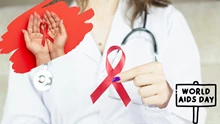
HIV, or Human Immunodeficiency Virus, is a virus that attacks the immune system, specifically the CD4 cells (T cells), crucial for fighting infections. If left untreated, HIV can progress to AIDS (Acquired Immunodeficiency Syndrome), a late stage characterized by severe immune system weakening, leading to life-threatening conditions.
Aids: Progression and Early Detection
For individuals not diagnosed or not on antiretroviral therapy (ART), signs of HIV-related illness may emerge within 5–10 years, though it can happen sooner. The time from HIV transmission to an AIDS diagnosis typically spans 10-15 years, with some rare cases of individuals, termed 'elite-controllers,' managing HIV without ART. However, most people require ART to prevent illness.
Aids: Transmission of HIV
HIV is present in certain bodily fluids, such as blood, semen, vaginal fluids, rectal fluids, and breast milk. The primary mode of transmission is through unprotected sexual intercourse with an infected person. Other modes include sharing needles, receiving contaminated blood products or organs, and mother-to-child transmission during childbirth or breastfeeding. Unlike HIV, AIDS itself is not transmitted; it results from untreated or advanced HIV infection.
Aids: Treatment
Antiretroviral therapy (ART) is the cornerstone of HIV treatment. ART combines medications to suppress the virus, allowing the immune system to recover and preventing further damage. By maintaining an undetectable viral load, individuals on ART can avoid transmitting HIV to their sexual partners. This treatment enables people with HIV to lead long and healthy lives by ensuring a robust immune system.
Aids: Prevention Strategies
-
Safe Sex Practices- Practicing safe sex by using barrier methods such as condoms significantly reduces the risk of HIV transmission during sexual intercourse.
-
Needle Safety- Using sterile needles is crucial to prevent HIV transmission among individuals who inject drugs. This includes avoiding needle-sharing practices.
-
Regular Testing- Regular HIV testing is vital, especially for those engaging in high-risk activities. Early detection allows for timely medical intervention, significantly improving prognosis.
-
Awareness and Stigma Reduction- Raising awareness about HIV/AIDS and reducing stigma are essential components of prevention efforts. This includes promoting understanding and empathy to foster a supportive environment.
HIV is the virus that leads to AIDS, a condition marked by severe immune system compromise. Early detection and timely medical intervention, particularly through antiretroviral therapy, can significantly improve outcomes. Preventing HIV transmission involves safe sex practices, needle safety, regular testing, and comprehensive awareness campaigns to reduce stigma.
Also Read: - Nitin Gadkari to be the Chief Guest for 'MFOI Awards 2023'; Flag Off 'MFOI Kisan Bharat Yatra'









